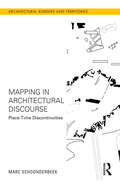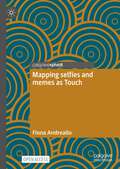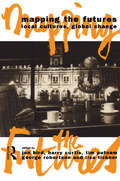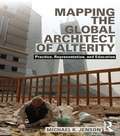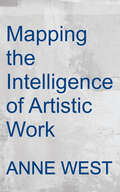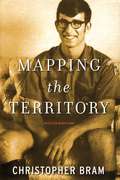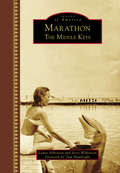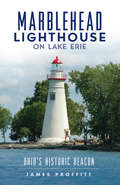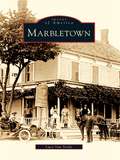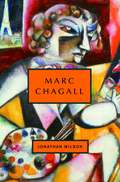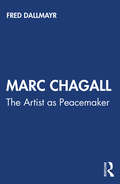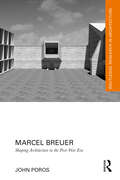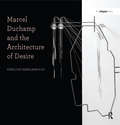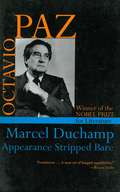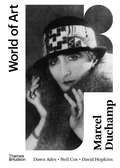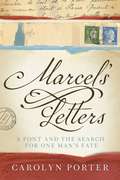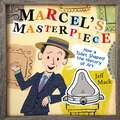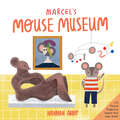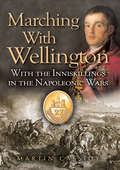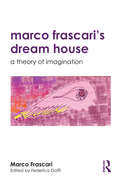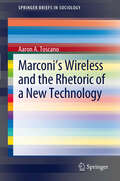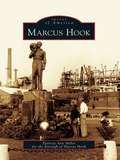- Table View
- List View
Mapping in Architectural Discourse: Place-Time Discontinuities (Architectural Borders and Territories)
by Marc SchoonderbeekThis book explores the notion of mapping in architectural discourse. First locating, positioning and theorizing mapping, it then makes explicit the relationship between research and design in architecture through cartography and spatial analysis. It proposes three distinct modalities: tool, operation and concept, showing how these methods lead to discursive aspects of architectural work and highlighting mapping as an instrument in developing architectural form. It emphasizes the importance of place and time as fundamental terms with which to understand the role of mapping. An investigation into architectural discourse, this book will appeal to academics and researchers within the discipline with a particular interest in theory, history and cartography.
Mapping selfies and memes as Touch
by Fiona AndrealloThis open access book offers a rich and nuanced analysis of digitally networked socialities as culturally meaningful relationships of Touch. Focusing on the ways Touch is practised in everyday social interactions serves as a basis for how Touch is understood as multiply significant – physically, emotionally, intellectually and politically. Andreallo initiates a map of the fundamentals of Touch and how they can be considered for future research in considering digitally networked cultures. This map also serves as a basis for closely examining selfies and memes. Examining social networks of Touch, Andreallo focuses on a specific example of the PrettyGirlsUglyFaces meme and ugly selfies(uglies). Through this example, memes and selfies are mapped as Touch involving textures of both intimacy and violence. Andreallo also discusses technological seamlessness and cultural semefulness as conversations of social relationships of Touch, and proposes the term semeful sociabilities to describe how the everyday technological self engages in practices of Touch. This book is a compact, approachable insight into selfies and memes as everyday culturally networked Touch relationships that also offers a way forward in recognising technological relationships as culturally meaningful.
Mapping the Futures: Local Cultures, Global Change (FUTURES: New Perspectives for Cultural Analysis)
by Tim Putnam George Robertson Lisa Tickner Jon Bird Barry CurtisThere are now new experiences of space and time; new tensions between globalism and regionalism, socialism and consumerism, reality and spectacle; new instabilities of value, meaning and identity - a dialectic between past and future. How are we to understand these? Mapping the Futures is the first of a series which brings together cultural theorists from different disciplines to assess the implications of economic, political and social change for intellectual inquiry and cultural practice.
Mapping the Global Architect of Alterity: Practice, Representation and Education
by Michael JensonDue to globalization, cultural spaces are now developing with no tangible connection to geographical place. The territorial logic traditionally used to underpin architecture and envision our built environment is being radically altered, forcing the adoption of a new method of conceptualizing space/geography and what constitutes architectural practice. Construction techniques, design sensibilities, and cultural identities are being transformed as technology transports us to places that were previously unreachable. The resultant "globalized" architect must become more than just an artful visionary, but also a master of the art of the political nudge willing to act within multiple mediums and at the simultaneous scales of a chaotic new world disorder. Though fearless they must also be responsible, inherently understanding the necessity to align bold visions with the mundane details of the everyday in ways that are culturally flexible and accepting of change. The potential for what must be considered the legitimate practice of the architect must move from a purely material venue to one more directly engaged in the chaos of the larger economic, political, and social spheres of a globalizing world. The issues and possible interactions with globalization contained in this text exemplify ways that architecture is transforming into a more flexible and fluid interdisciplinary version of its traditional self in order to rise to challenges of this new international terrain. A theme runs throughout in the form of a call: that architects must conceptually re-construct their frames of reference to better align with the demands of a rapidly globalizing world.
Mapping the Intelligence of Artistic Work: An Explorative Guide to Making, Thinking, and Writing
by Anne WestIn this timely book West describes a technique she calls 'mapping through writing' that encourages visual artists to ask strategic questions, approach problems, and catalyze creative thinking. The book is structured as a series of exercises and prompts that define the mapping process and introduce methods for artists to develop, articulate, and disseminate ideas. Mapping the Intelligence of Artistic Work was edited by Moth Press Director Katarina Weslien. According to Weslien, "Anne West has cultivated a flexible, non-linear writing approach for the artist-writer. Mapping the Intelligence of Artistic Work introduces multiple skill sets to stimulate creative thinking, raising connections to the surface by creating visual maps of interconnecting links. It is a book supportive of the making process, an invaluable tool for anyone interested in articulating the layers of meaning embedded in the process of making."
Mapping the Territory: Selected Nonfiction
by Christopher BramNovelist Christopher Bram has been writing essays for twenty-five years. Mapping the Territory, his first collection of nonfiction, ranges through such topics as the power of gay fiction, coming out in the 1970s in Virginia, low-budget filmmaking with friends in New York, and the sexual imagination of Henry James. He describes the heady experience of seeing his novel Gods and Monsters made into an Oscar-winning movie starring Ian McKellen, Brendan Fraser, and Lynn Redgrave; and he discusses why he and his partner of thirty years don't want to get married. Bram looks both into and out of himself in these essays. He revisits the titles he read while finding himself as a gay man, and he also shows us Greenwich Village as seen from his front stoop. The book is not simply a collection of short pieces--it's an autobiography of ideas from one of today's most lively and popular novelists.
Maquiagem Simples, De Baixo Custo & Dicas De Beleza Que As Modelos Usam
by James Abbott Talita FerreiraBeauty You – Maquiagem simples, de baixo custo & Dicas de beleza que os modelos usam Não se preocupe com transformações caras e demoradas! Neste guia você vai aprender as dicas simples e baratas que mais funcionam e que vão fazer de você uma modelo! São os métodos usados pelas mais bem sucedidas modelos do mundo e que podem ser feito por iniciantes em poucos minutos. Este livro contém: Dicas simples Métodos de baixo custo Automaquiagem rápida em minutos O look das modelos A melhor maquiagem para qualquer ocasião Aviso Legal: Este autor e detentor de direitos não fazem reivindicações, promessas ou garantias sobre a exatidão, integridade ou aplicação do conteúdo deste livro, e se isenta expressamente da responsabilidade por erros e omissões nos conteúdos nele contidos. Este produto é apenas para referência. Gênero: SAÚDE E FITNESS / Beleza & Embelezamento Gênero Secundário: TRABALHOS MANUAIS & HOBBIES / Moda Língua: Inglês / Língua: Português Palavras-chave: vaidade, escova, aparência, maquiagem, beleza, produtos de beleza, marcas, esponja, modelos, transformação Contagem de palavra: 1938 (Inglês) / 2.036 (Português) Links de livros: Amazon
Marathon: The Middle Keys (Images of America)
by Jerry Wilkinson Laura Albritton Tom HambrightThe Middle Keys have experienced a fascinating history, from the time when wreckers plied the Florida Reef to the days of Henry Flagler's audacious overseas railroad. Once the Overseas Highway opened, travelers could reach Marathon by car and tourism boomed. As more people settled in Marathon, the community grew and flourished. The majesty of the Middle Keys' two Seven Mile Bridges has inspired postcards, paintings, and even movie scenes. Local institutions like the Dolphin Research Center and the Turtle Hospital have also garnered a host of fans. Images of America: Marathon: The Middle Keys captures the story of these unique islands and their rich photographic legacy.
Marblehead Lighthouse on Lake Erie: Ohio’s Historic Beacon (Landmarks)
by James ProffittWhen the Marblehead Lighthouse first lit its flame in 1822, it drew on whale oil. The beacon flickered through lard, kerosene and LED lights over the next two centuries, while the tower weathered razing and reorganization. Despite the advent of GPS, the light still provides a solid basis for boats and ships to navigate the nearshore waters of the peninsula. The lighthouse's rich history boasts the first female keeper on the Great Lakes, as well as a place on Ohio license plates and on a U.S. postage stamp. James Proffitt gives an in-depth profile of the most photographed site in the state.
Marbletown
by Lucy Van SickleMarbletown, one of the many wonders of the Hudson Valley, is located in the rich historical area of the Catskills. Just six miles south of Kingston on the Old Mine Road, Marbletown once served as the capital of New York State, when Kingston was burned by the British in 1777. The township is made up of the individual hamlets of Cottekill, High Falls, Kripplebush, Lomontville, Stone Ridge, Marbletown, and Vly Atwood. Through vintage photographs, Marbletown provides a glimpse of how early residents lived, capturing the distinct personalities that have shaped the township's history and drawn generations eager to experience the beauty of Marbletown and the charm of its people.
Marc Chagall (Getting to Know the World's Greatest Artists)
by Mike VeneziaDiscusses the life and work of the artist Chagall, from his birth in Russia to his death at the age of ninety-seven.
Marc Chagall (Jewish Encounters Series)
by Jonathan WilsonNovelist and critic Jonathan Wilson clears away the sentimental mists surrounding an artist whose career spanned two world wars, the Russian Revolution, the Holocaust, and the birth of the State of Israel. Marc Chagall's work addresses these transforming events, but his ambivalence about his role as a Jewish artist adds an intriguing wrinkle to common assumptions about his life. Drawn to sacred subject matter, Chagall remains defiantly secular in outlook; determined to "narrate" the miraculous and tragic events of the Jewish past, he frequently chooses Jesus as a symbol of martyrdom and sacrifice. Wilson brilliantly demonstrates how Marc Chagall's life constitutes a grand canvas on which much of twentieth-century Jewish history is vividly portrayed. Chagall left Belorussia for Paris in 1910, at the dawn of modernism, looking back dreamily on the world he abandoned. After his marriage to Bella Rosenfeld in 1915, he moved to Petrograd, but eventually returned to Paris after a stint as a Soviet commissar for art. Fleeing Paris steps ahead of the Nazis, Chagall arrived in New York in 1941. Drawn to Israel, but not enough to live there, Chagall grappled endlessly with both a nostalgic attachment to a vanished past and the magnetic pull of an uninhibited secular present. Wilson's portrait of Chagall is altogether more historical, more political, and edgier than conventional wisdom would have us believe-showing us how Chagall is the emblematic Jewish artist of the twentieth century. Visit nextbook. org/chagall for a virtual museum of Chagall images. From the Hardcover edition.
Marc Chagall: The Artist as Peacemaker (Peacemakers)
by Fred DallmayrThis book follows Chagall’s life through his art and his understanding of the role of the artist as a political being. It takes the reader through the different milieus of the nineteenth and twentieth centuries – including the World Wars and the Holocaust – to present a unique understanding of Chagall’s artistic vision of peace in an age of extremes. At a time when all identities are being subsumed into a “national” identity, this book makes the case for a larger understanding of art as a way of transcending materiality. The volume explores how Platonic notions of truth, goodness, and beauty are linked and mutually illuminating in Chagall’s work. A “spiritual-humanist” interpretation of his life and work renders Chagall’s opus more transparent and accessible to the general reader. It will be essential reading for students of art and art history, political philosophy, political science, and peace studies.
Marcel Breuer: Shaping Architecture in the Post-War Era (Routledge Research in Architecture)
by John PorosThis book tracks the development of Marcel Breuer’s aesthetic clash between uniformity and singularity through the detailed examination of his seminal buildings. Each chapter examines a specific building and puts into context Breuer’s other work and the contemporary movements/architects of the post-war era such as Surrealism, Brutalism and structural expressionism. The buildings examined include the UNESCO Headquarters in Paris, France, of 1958; the IBM Research Center in Le Gaude, France, of 1962; the Annunciation Priory in Bismark, North Dakota, of 1963; and the Atlanta Central Library of 1980. Marcel Breuer’s approach to design was inspired by the Spanish phrase, sol y sombra (sun and shadow). Sun and shadow meant for Breuer that a juxtaposition of contrasts was necessary; light glass walls and heavy concrete, masses lifted over voids, and serial precast construction resting on sculptural columns became hallmarks of Breuer’s buildings. By creating an architecture of juxtaposition, Breuer’s work can be interpreted as a surrealist recontre, as fueling a new architectural condition. A critical evaluation of Marcel Breuer’s work, this book is written for graduate students, researchers, and academics interested in his work and how it shaped the architecture of the post-war era.
Marcel Duchamp and the Architecture of Desire (Design Research in Architecture)
by Penelope HaralambidouWhile much has been written on Marcel Duchamp - one of the twentieth century's most beguiling artists - the subject of his flirtation with architecture seems to have been largely overlooked. Yet, in the carefully arranged plans and sections organising the blueprint of desire in the Large Glass, his numerous pieces replicating architectural fragments, and his involvement in designing exhibitions, Duchamp's fascination with architectural design is clearly evident. As his unconventional architectural influences - Niceron, Lequeu and Kiesler - and diverse legacy - Tschumi, OMA, Webb, Diller + Scofidio and Nicholson - indicate, Duchamp was not as much interested in 'built' architecture as he was in the architecture of desire, re-constructing the imagination through drawing and testing the boundaries between reality and its aesthetic and philosophical possibilities. Marcel Duchamp and the Architecture of Desire examines the link between architectural thinking and Duchamp's work. By employing design, drawing and making - the tools of the architect - Haralambidou performs an architectural analysis of Duchamp’s final enigmatic work Given: 1. The Waterfall, 2. The Illuminating Gas... demonstrating an innovative research methodology able to grasp meaning beyond textual analysis. This novel reading of his ideas and methods adds to, but also challenges, other art-historical interpretations. Through three main themes - allegory, visuality and desire - the book defines and theorises an alternative drawing practice positioned between art and architecture that predates and includes Duchamp.
Marcel Duchamp: Appearance Stripped Bare (Alianza Forma Ser.)
by Octavio PazOctavio Paz conveying "his awareness of Duchamp as a great cautionary figure in our culture, warning us with jest and quiet scandals of the menacing encroachment of criticism, science and even art." -New York Times Book Review
Marcel Duchamp: Second Edition (World of Art #0)
by David Hopkins Neil Cox Dawn AdesA revised and expanded edition of one of the most original books ever written on the enigmatic artist Marcel Duchamp. Genius, anti-artist, charlatan, guru, impostor? Since he arrived on the scene in 1914, Marcel Duchamp has been called all of these. Almost no other artist of the twentieth century has inspired more passion and controversy, nor exerted a greater influence on art. At the same time, Duchamp continually challenged the very nature of art and strove to redefine it as conceptual rather than as product by questioning why the medium was mostly a "retinal" experience. Always the provocateur, Duchamp never ceased to be engaged, openly or secretly, in activities and works that transformed traditional artmaking. Through his works like Fountain; Bicycle Wheel; L.H.O.O.Q.; and Nude Descending a Staircase, No. 2, Duchamp played with the idea of what art can be, opening new possibilities for future generations. This revised entry in the World of Art series, written by three leading experts on twentieth-century art, and published with support of Duchamp’s widow, is one of the most original books written on this enigmatic artist. Featuring a new chapter and preface, as well as updates throughout from specialist scholars who are active in their fields, this is the definitive introduction to Duchamp. Thoroughly illustrated, this volume combines thirty years of research by the authors and challenges history’s presumptions, misunderstandings, and pieces of misinformation about Marcel Duchamp and his legacy.
Marcel's Letters: A Font and the Search for One Man's Fate
by Carolyn PorterFinalist for the 2018 Minnesota Book AwardA graphic designer’s search for inspiration leads to a cache of letters and the mystery of one man’s fate during World War II.Seeking inspiration for a new font design in an antique store in small-town Stillwater, Minnesota, graphic designer Carolyn Porter stumbled across a bundle of letters and was immediately drawn to their beautifully expressive pen-and-ink handwriting. She could not read the letters-they were in French-but she noticed all of them had been signed by a man named Marcel and mailed from Berlin to his family in France during the middle of World War II.As Carolyn grappled with designing the font, she decided to have one of Marcel’s letters translated. Reading it opened a portal to a different time, and what began as mere curiosity quickly became an obsession with finding out why the letter writer, Marcel Heuzé, had been in Berlin, how his letters came to be on sale in a store halfway around the world, and, most importantly, whether he ever returned to his beloved wife and daughters after the war.Marcel’s Letters is the incredible story of Carolyn’s increasingly desperate search to uncover the mystery of one man’s fate during WWII, seeking answers across Germany, France, and the United States. Simultaneously, she continues to work on what would become the acclaimed P22 Marcel font, immortalizing the man and his letters that waited almost seventy years to be reunited with his family.
Marcel's Masterpiece: How a Toilet Shaped the History of Art
by Jeff MackAn engaging, kid-friendly introduction to artist Marcel Duchamp and how he turned a toilet into a famous work of art.This is the story of Marcel Duchamp and how the Dada art movement changed the way people thought about what art could be, and what could be art. From drawing a moustache on the Mona Lisa to attaching a bicycle wheel to a stool, Duchamp's work challenged long-held notions of art and how it should be made. People were amused, confused, and sometimes offended, and that was just the way Marcel Duchamp liked it.With Marcel's Masterpiece, Jeff Mack explores Duchamp's most famous provocation, and asks readers to ponder the ideas that help us see the world in new and interesting ways.
Marcel's Mouse Museum
by Hannah AbboThe Marcel's Mouse Museum is home to paintings and sculptures by the most famous mice of the last one hundred years, from Parmesan Picasso to Gouda Kahlo. Take a tour of mouse art history and styles with Curator Marcel and learn about art movements and styles like Cubism, self-portraits, Pop Art, and many more that have influenced art today. And we can&’t forget the cheesy fun facts and activities that go with them! With adorable mice drawn in famous artwork and an entertaining mix of mouse humor and history facts, Marcel's Mouse Museum is both educational and fun! Plus, each artist comes with an activity to try at home, perfect for inspiring the artist in everyone. The entire experience will be un-brie-lievable!
Marching with Wellington: With the Inniskillings in the Napoleonic Wars
by Martin CassidyCompiled from hitherto unpublished diaries and letters, this book tells of the dangers and rigors of life as experienced by the Infantry during the Napoleonic Wars. A superbly researched work by an expert historian, it captures the atmosphere of the era with total immediacy made possible only because the writers were actually there.
Marco Bellocchio
by Clodagh BrookMarco Bellocchio is one of Italy's most important and prolific directors, with a career spanning five decades. In this book, Clodagh J. Brook explores the boundaries between the public and the private, the political and the personal, and the collective and the individual as they appear in Bellocchio's films. Including work on psychoanalysis, politics, film production, autobiography, and the relationship between film tradition and contemporary culture, Marco Bellocchio touches on fundamental issues in film analysis.Brook's study interrogates what it means to make personal or anti-institutional art in a medium dominated by a late-capitalist industrial model of production. Her readings of Bellocchio's often enigmatic and perplexing work suggest new ways to answer questions about subjectivity, objectivity, and political commentary in modes of filmmaking. Relating the art of a private director to a public medium, Clodagh J. Brook's work is an important contribution to our understanding of film.
Marco Frascari's Dream House: A Theory of Imagination
by Federica Goffi Marco FrascariThis previously unpublished work is essential reading for anyone who has followed Marco Frascari’s scholarship and teachings over the last three decades. It also provides the perfect introduction for anyone new to his writings. As ever, Frascari does not offer prescriptive tools and frameworks to enact his theories of drawing and imagination; instead, he teaches how to build one’s own through individual practice. An illuminating introduction places the text in a wider context, providing the reader with a fascinating and important context and understanding to this posthumous work. Frascari's sketchbooks are reproduced faithfully in full colour to provide the reader with a remarkable insight into the design process of this influential mind.
Marconi's Wireless and the Rhetoric of a New Technology
by Aaron ToscanoThis book examines the discourse surrounding the wireless, created by the Anglo-Italian inventor Guglielmo Marconi. The wireless excited early twentieth-century audiences before it even became a viable black box technology. The wireless adhered to modernist values--speed, efficiency, militarization, and progress. Language surrounding the wireless is a form of technical communication, overlooked by today's practitioners. This book establishes a broader definition for technical communication by examining a selection of the discourse surrounding Marconi's wireless. The book's main themes are the following: 1) technical communication is all discourse surrounding technology, 2) the field of technical communication (or technical writing) should incorporate analyses of discourse surrounding technologies into its epistemology, 3) the wireless is a product of the society from which it comes (early twentieth-century Western civilization), and 4) the discourse surrounding the wireless is infused with tropes of progress--speed, efficiency, evolution, and ahistoricity.
Marcus Hook
by Borough of Marcus Hook Patricia Ann MillerMarcus Hook is the northernmost city on the Delmarva Peninsula. Incorporated in 1892, Marcus Hook was originally named for a Native American chief and was once the haunt of English pirate Edward Teach (Blackbeard). It is now best known as the home of SunOil Refinery. Thanks to its location along the Delaware River, the town prospered as residents and businesses flocked to the area. Other large businesses located here include the former American Viscose and British Petroleum. Through vintage photographs, Marcus Hook commemorates the longstanding heritage of this small community and the growth of the Delaware River waterfront.
